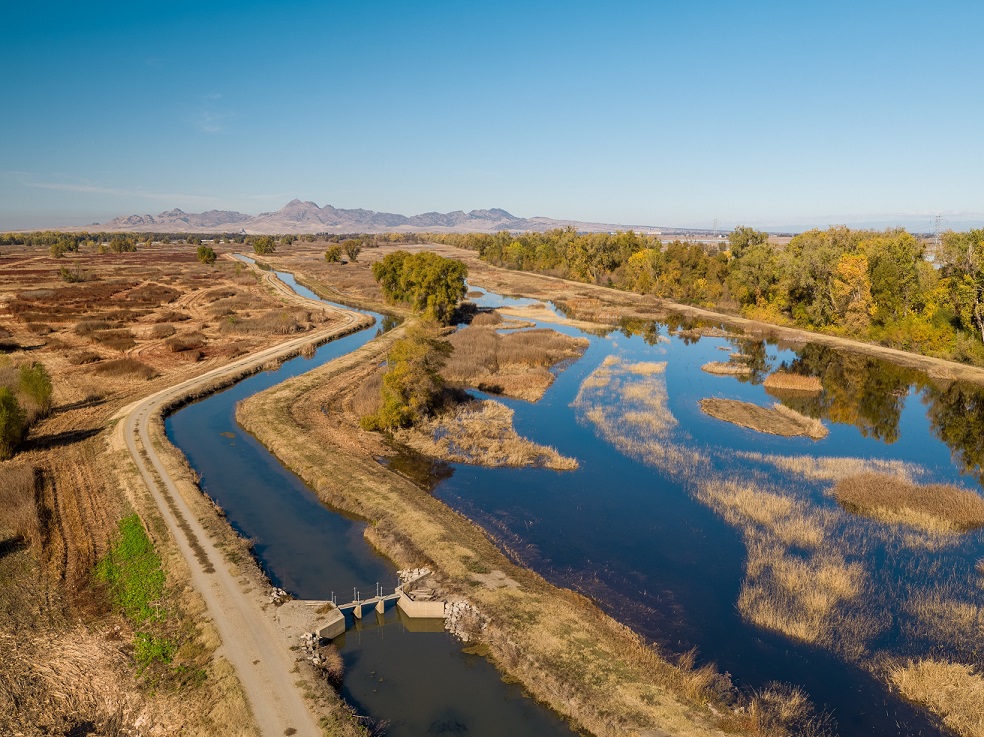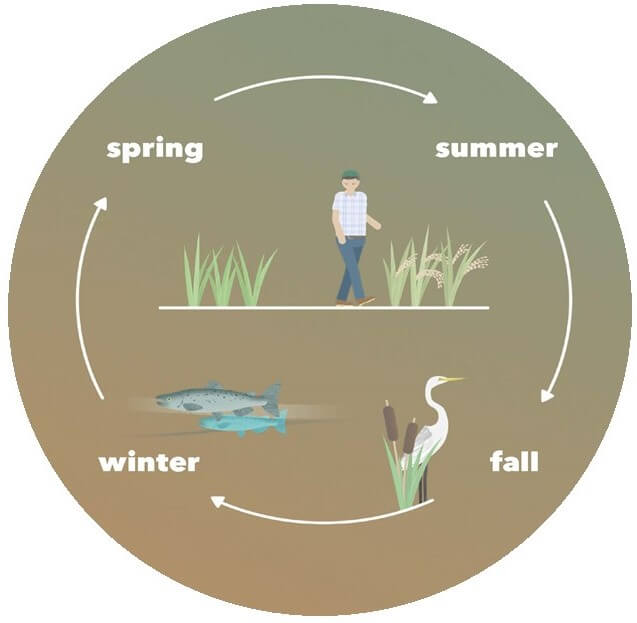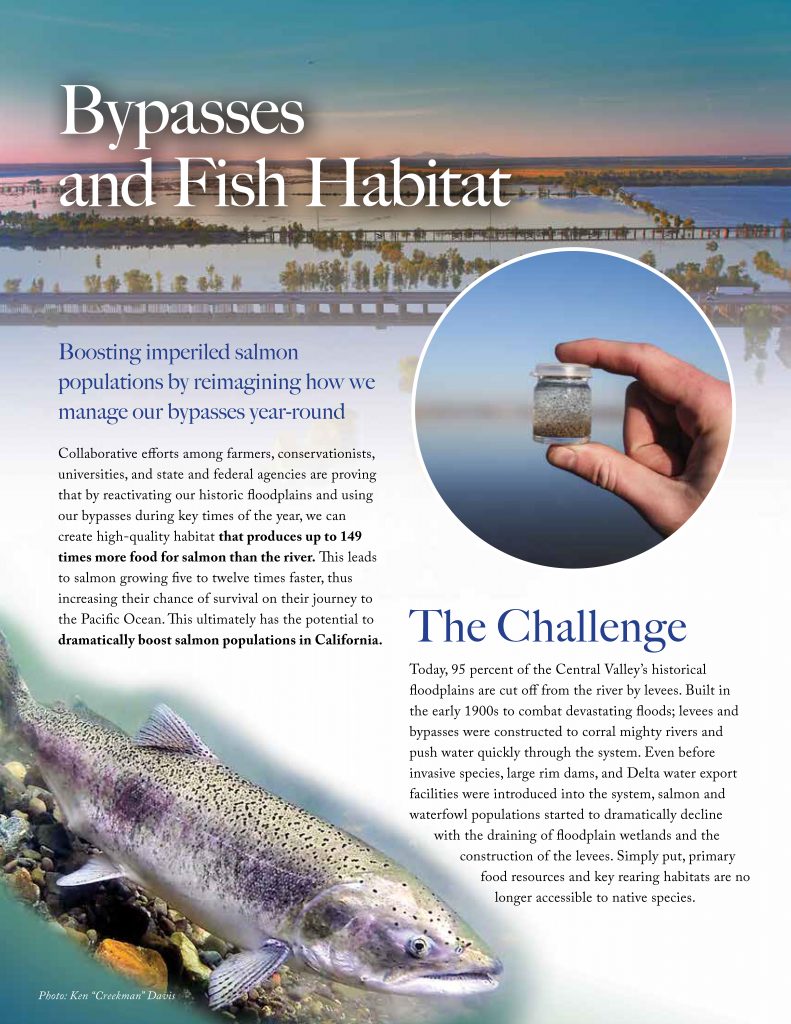By David Guy
Today, 95% of the Central Valley’s historical floodplains are cut off from the river by levees. Built in the early 1900s to combat devastating floods, levees and bypasses were constructed to corral mighty rivers and push water quickly through the system. Even before invasive species, large rim dams, and Delta water export facilities were introduced into the system, salmon populations started to dramatically decline with the construction of the levees. Simply put, the levees prevented Chinook salmon from accessing their primary food source. To address the problem of access, a diverse group of government agencies, conservation groups, growers and water suppliers came together to dream big – this group is now referred to as the Floodplain Forward Coalition. Their task, as illustrated in the document below: reconnect the fish with the food and provide them a safe haven.

Our bypasses are engineered to push water out of the system as quickly as possible when the Sacramento Valley floods. This primary function reduces the threat of flooding to our cities, communities and farms. We are now uncovering ways to re-imagine and better use our bypasses to also benefit fish and wildlife without impacting the primary function: flood protection. By reactivating our floodplains and allowing bypasses to connect to the river more frequently and for longer durations we can mimic historical flood patterns and restore the natural wetland productivity needed to recover imperiled fish and wildlife populations.
With the ability to move water during non-flood times to farmlands and other managed wetlands along the bypasses, we can create large shallow sections of water on dormant fields. The water, only a few inches deep, spreads out and slows down and acts as a giant solar panel producing billions of zooplankton. This primary food source for endangered salmon is severely lacking in the rivers alone, but on the traditional floodplains, the food is bountiful. For the first time in decades young salmon have access to large swaths of food and a safe haven from predator fish.
Projects within the flood protection bypasses create managed seasonal wetland habitat on agricultural lands that include perimeter berms and water-control structures, increasing the duration of flood events and allowing the water residence time necessary for aquatic food web production. These projects will provide volitional passage for salmon to enter and exit the floodplain fields at will, providing access to Floodplain Reactivation in the Sacramento River Basin for Fish and Wildlife: Working Lands on Both Sides of the Levees, high food-density foraging opportunities, refuge from predators, and an unimpeded migration corridor through the Golden Gate out to the ocean. Inundation of the floodplain will occur during the late fall and winter months to benefit all runs of salmon and allow for continued farming during the growing season.

These projects will be operated in conjunction with new enhanced fish passage at various weirs to increase the frequency of floodplain activation and optimize adult fish passage through the bypasses. These bypass projects on the wet side of the levee have the potential to create about 20,000 acres of fish-accessible floodplain habitat.
A multi-year study led by UC Davis Center for Watershed Sciences, Department of Water Resources, Department of Fish and Wildlife, Delta Stewardship Council and California Trout reveals astonishing results: Zooplankton (bug) densities were up to 149 times higher in the bypasses compared to tested sites in the adjacent Sacramento River. Juvenile salmon feeding on the bypass grew 5 to 12 times faster compared to fish that only ate in the Sacramento River. This rapid growth among juvenile salmon is vital for the salmon’s overall health, ability to evade predators and the strength required for the species to reach the Pacific Ocean for the next phase of their lifecycle. The bigger and stronger they are as juveniles helps improve the chances the salmon come back to the river to spawn as adults.
The Floodplain Forward Coalition continues to grow as more conservationists, farmers, ranchers, scientists, and public agencies are coming together to be a part of the solution. The “New Way Forward” entails a collaborative approach to water management and habitat creation. The winning formula of “Science + Agricultural Lands + Collaboration” has proven to be the most successful way at achieving results in a complex web of water policy and regulations in California. The efforts don’t stop with endangered fish. If robust population numbers of salmon are realized, we will collectively have the opportunity to use and manage water resources to benefit more fish and wildlife.
Explore and please click on the document below to learn more about this incredible effort, as well as the invaluable Floodplain Forward Coalition – without whom this progress wouldn’t be possible. More information on floodplain reactivation is available on the homepage at www.norcalwater.org.




